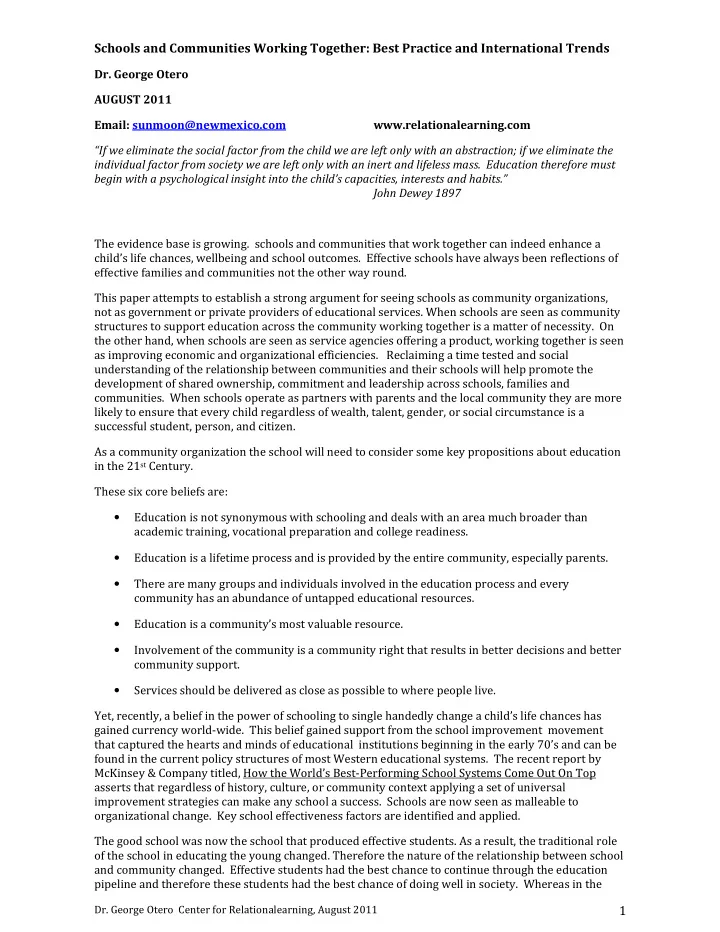

Schools and Communities Working Together: Best Practice and International Trends Dr. George Otero AUGUST 2011 Email: sunmoon@newmexico.com www.relationalearning.com “If we eliminate the social factor from the child we are left only with an abstraction; if we eliminate the individual factor from society we are left only with an inert and lifeless mass. Education therefore must begin with a psychological insight into the child’s capacities, interests and habits.” John Dewey 1897 The evidence base is growing. schools and communities that work together can indeed enhance a child’s life chances, wellbeing and school outcomes. Effective schools have always been reflections of effective families and communities not the other way round. This paper attempts to establish a strong argument for seeing schools as community organizations, not as government or private providers of educational services. When schools are seen as community structures to support education across the community working together is a matter of necessity. On the other hand, when schools are seen as service agencies offering a product, working together is seen as improving economic and organizational efficiencies. Reclaiming a time tested and social understanding of the relationship between communities and their schools will help promote the development of shared ownership, commitment and leadership across schools, families and communities. When schools operate as partners with parents and the local community they are more likely to ensure that every child regardless of wealth, talent, gender, or social circumstance is a successful student, person, and citizen. As a community organization the school will need to consider some key propositions about education in the 21 st Century. These six core beliefs are: Education is not synonymous with schooling and deals with an area much broader than • academic training, vocational preparation and college readiness. Education is a lifetime process and is provided by the entire community, especially parents. • There are many groups and individuals involved in the education process and every • community has an abundance of untapped educational resources. Education is a community’s most valuable resource. • Involvement of the community is a community right that results in better decisions and better • community support. Services should be delivered as close as possible to where people live. • Yet, recently, a belief in the power of schooling to single handedly change a child’s life chances has gained currency world-wide. This belief gained support from the school improvement movement that captured the hearts and minds of educational institutions beginning in the early 70’s and can be found in the current policy structures of most Western educational systems. The recent report by McKinsey & Company titled, How the World’s Best-Performing School Systems Come Out On Top asserts that regardless of history, culture, or community context applying a set of universal improvement strategies can make any school a success. Schools are now seen as malleable to organizational change. Key school effectiveness factors are identified and applied. The good school was now the school that produced effective students. As a result, the traditional role of the school in educating the young changed. Therefore the nature of the relationship between school and community changed. Effective students had the best chance to continue through the education pipeline and therefore these students had the best chance of doing well in society. Whereas in the Dr. George Otero Center for Relationalearning, August 2011 1
past the school was an instrument of the community, the modern school, whether public or private, had emerged as a service providing academic success and a ticket to higher education and the good life. Schools and Communities Together: An Education for the Whole Child Educators, policy makers and the wider community are beginning to recognize that increasing a child’s life chances depend upon the action of the community and the school in concert. Citizens in most countries are being called on to broaden their understanding of what schools and society need to do to support the development of well-rounded students ready to thrive in the modern world. Educating the whole child includes not only fostering academic achievement, but also promoting physical and emotional health, offering a personalized education by qualified adults, strengthening students’ engagement with school and the wider community, and preparing them for success in postsecondary study and work. � !�����"�����������"� ���������� ������� ����������� ������� ��������� ��������������� ���������� ������������� ����������� �������� ������� ������� � Figure 1 �� ���������������������������������������������������������������� The three factors at the top of the diagram, which are italicised, are in a different category to the rest as they are essentially inherited; in the normal course of events there is nothing that can be done to change them – assuming that change was necessary or desirable. What is very clear is that in certain circumstances gender, ethnicity and disability can have significant negative implications in terms of life chances. In other circumstances they can have highly beneficial implications – it seems to depend on context. The other three variables are not fixed in the way of the first three factors i.e. they can be influenced, changed and mitigated. The social variables are essentially contextual; they describe the social situation of every child and young person. The personal variables are the factors that explain the distinctive identity of every person – what makes us who we are. The school as a variable is significant in that it is probably the one common factor in every person’s life and in some respects is the most controllable of all. Taken from: Schools and Communities: Working Together to Transform Children’s Lives, John West- Burnham, Maggie Farrar, George Otero, Continuum Press, 2007. Dr. George Otero Center for Relationalearning, August 2011 2
Recommend
More recommend